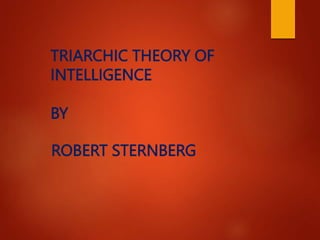
Triarchic Theory of Intelligence by Robert Sternberg (1) (1).pptx
- 1. TRIARCHIC THEORY OF INTELLIGENCE BY ROBERT STERNBERG
- 2. JEAN PIAGET (1896-1980) COGNITIVE DEVELOPMENT FROM BIRTH TO ADOLESCENCE Cognitive Development Children actively construct their understanding of the world. As children grow , additional information is acquired and they adapt their thinking to include new ideas, as this improves their understanding of the world.
- 4. TRIARCHIC THEORY OF INTELLIGENCE ROBERT STERNBERG (1985) Sternberg views intelligence as “ the ability to adapt, to shape and to Select environment to accomplish one’s goals and those of one’s society and culture”.
- 5. Triarchic Theory of Intelligence According to this theory there are three basic types of intelligence: Componential, Experiential and Contextual The elements of the triarchic theory of intelligence are shown in figure 1.1
- 6. Fig 1.1 Elements of Triarchic Theory of Intelligence
- 7. Componential Intelligence Componential or analytical intelligence is the analysis of information to solve problems. Persons high on this ability think analytically and critically and succeed in schools.
- 8. Componential Intelligence This intelligence has three components, each serving a different function. First is the knowledge acquisition component, which is responsible for learning and acquisition of the ways of doing things.
- 9. Componential Intelligence The second is the meta or a higher order component, which involves planning concerning what to do and how to do. The third is the performance component, which involves actually doing things.
- 10. Experiential Intelligence Experiential or creative intelligence is involved in using past experiences creatively to solve novel problems. It is reflected in creative performance. Persons high on this aspect integrate different experiences in an original way to make new discoveries and inventions. They quickly find out which information is crucial in a given situation.
- 11. Activity 1.2 On the ‘Practical’ Track You have just been admitted into a school/college. You will take three examinations during the entire year. You sincerely want to receive high marks in the course. How likely are you to engage in each of the following actions?
- 12. Activity 1.2 • Attend classes regularly. • Create study groups with your friends for weekly discussions. • Take detailed notes in the class. • Join a tutorial/coaching centre. • Prepare written notes for each chapter. • Read the textbook chapters thoroughly. • Solve the questions of the last three years.
- 13. Contextual Intelligence Contextual or practical intelligence involves the ability to deal with environmental demands encountered on a daily basis. It may be called ‘street smartness’ or ‘business sense’.
- 14. Contextual Intelligence Persons high on this aspect easily adapt to their present environment or select a more favourable environment than the existing one, or modify the environment to fit their needs. Therefore, they turn out to be successful in life.
- 15. Contextual Intelligence Sternberg’s triarchic theory of intelligence represents the information processing approach to understand intelligence
- 16. Answer the following question 1.Ability to use past experience creatively to solve novel problems is known as: a) Musical intelligence b) Interpersonal intelligence c) Experiential intelligence d) Contextual intelligence
- 17. Answer the following question 2. ‘Selection of environment to accomplish one’s goal and those of one’s society and culture is an intelligent act. Its given by: a) Sternberg b) J.P.Guilford c) Charles Spearman d) Louis Thurstone
- 18. Answer the following questions 3. How sternberg’s concept of intelligence is different from other concepts? 4. Explain contextual intelligence with help of an example? 5. Explain componential intelligence with an example? 6. How does the Triarchic theory help us to understand intelligence?
- 19. References NCERT Psychology, Text for Class XI , Human Development, Jean Piaget cognitive development theory page 71-72 NCERT Psychology, Text for Class XII Chapter 1 Variations in Psychological Attributes Page 8-9 Images from Google search
- 20. Varadarajan Sundaramahalingam Senior Psychology Teacher